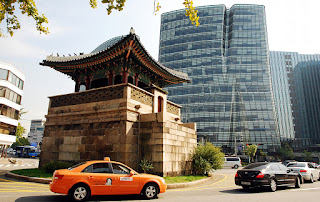 |
| Welcome to my final blog of my trip to South Korea. This amazing tree can be found at the Jogyesa Temple |
 |
| Jogyesa is the chief temple of the Jogye Order of Korean Buddhism |
 |
| The temple was first established in 1395, at the dawn of the Joseon Dynasty; the modern temple was founded in 1910 |
 |
| Changdeokgung Palace 창덕궁 was the second royal villa built following the construction of Gyeongbokgung Palace in 1405. Here you can see Donhwamun Gate - the main palace gate. Built in 1412, Donhwamun has a two-story pavilion-type wooden structure, and is the largest of all palace gates. Donhwamun was burned down during the Japanese invasion of 1592 and was restored in 1608 |
 | |
| Changdeokgung was the most favored palace of many Joseon princes and retained many elements dating from the Three Kingdoms of Korea period that were not incorporated in the more contemporary Gyeongbokgung. This is Injeongjeon, the throne hall. It was used for major state affairs including the coronation of a new king and receiving foreign envoys |
 |
| Like the other Five Grand Palaces in Seoul, it was heavily damaged during the Japanese occupation of Korea (1910-1945). Currently, only about 30% of the pre-Japanese structures survive. As you can see the buildings are spectacular |
 |
| The architectural style of Changdeokgung overall features simplicity and frugality because of Confucian ideology |
 |
| Gorgeous ceiling |
 |
| Changdeokgung was added to the UNESCO World Heritage List in 1997 |
 |
| A beautiful Palace and a fun playground for children |
 |
| Simplicity |
 |
| It's definitely true that the Changdeokgung Palace is less imposing and has a different atmosphere to the Gyeongbokgung |
 |
| Beautifully designed window |
 |
| A cute little visitor to the Palace |
 |
| Perfect |
 |
| Adjacent to the Changdeokgung Palace, is another Palace called Changgyeonggung. Originally the Summer Palace of the Goryeo Emperor, it later also became one of the Five Grand Palaces of the Joseon Dynasty. Unbeknown to me these ladies were here for a special occasion |
 |
| I was fortunate to witness and take some photographs of this special occasion for a Korean husband and wife |
 |
| This day was their 50th wedding anniversary.... |
 |
| ....and they came suitably attired.... |
 |
| ....in beautiful traditional costume |
 |
| The daughter of the couple had arranged this so they would have lovely memories |
 |
| It was a little stressful and formal for them posing for the photos but this smile says it all |
 |
| The entrance to the Changgyeonggung Palace called Honghwamun. It is now sunset and time for me to start preparations for my journey back to Singapore |
 |
| As I was leaving I was fortunate to bump into this little bundle of fun! |































